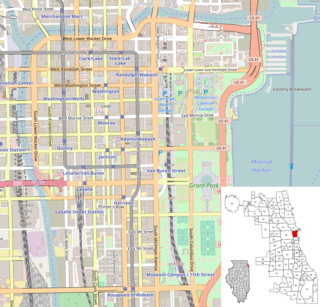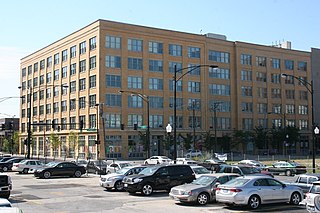
Chicago, officially the City of Chicago, is the most populous city in the U.S. state of Illinois, and the third most populous city in the United States. With an estimated population of 2,693,976 in 2019, it is also the most populous city in the Midwestern United States. Chicago is the county seat of Cook County, the second most populous county in the U.S., while a small portion of the city's O'Hare Airport also extends into DuPage County. Chicago is the principal city of the Chicago metropolitan area, defined as either the U.S. Census Bureau's Metropolitan Statistical Area or the Combined Statistical Area, often called Chicagoland. It constitutes the third most populous urban area in the United States after New York City and Los Angeles.

Harrisburg is a city in and the county seat of Saline County, Illinois, United States. It is located about 57 miles southwest of Evansville, Indiana and 111 mi (179 km) southeast of St. Louis, Missouri. The 2010 population was 9,017, and the surrounding Harrisburg Township had a population of 10,790, including the city residents. Harrisburg is included in the Illinois–Indiana–Kentucky tri-state area and is the principal city in the Harrisburg Micropolitan Statistical Area with a combined population of 24,913.

Rockford is a U.S. city in Winnebago County, Illinois, located in the far northern part of the state. Situated on the banks of the Rock River, Rockford is the county seat of Winnebago County. The largest city in Illinois outside of the Chicago metropolitan area, Rockford is the fourth-largest city in the state and the 171st most populous in the United States. According to 2010 U.S. Census data, the City of Rockford had a population of 152,871, with an outlying metropolitan area population of 348,360. Rockford's population was 145,609 as of 2019, down 5.0% since 2010.

Pullman, one of Chicago's 77 defined community areas, is a neighborhood located on the city's South Side. Twelve miles from the Chicago Loop, Pullman is situated adjacent to Lake Calumet.

The Financial District of Lower Manhattan, also known as FiDi, is a neighborhood located on the southern tip of Manhattan island in New York City. It is bounded by the West Side Highway on the west, Chambers Street and City Hall Park on the north, Brooklyn Bridge on the northeast, the East River to the southeast, and South Ferry and the Battery on the south.

Quincy Market is a historic market complex near Faneuil Hall in downtown Boston, Massachusetts. It was constructed in 1824–26 and named in honor of Mayor Josiah Quincy, who organized its construction without any tax or debt. The market is a designated National Historic Landmark and a designated Boston Landmark in 1996., significant as one of the largest market complexes built in the United States in the first half of the 19th century.

Douglas, on the South Side of Chicago, Illinois, is one of 77 Chicago community areas. The neighborhood is named for Stephen A. Douglas, Illinois politician and Abraham Lincoln's political foe, whose estate included a tract of land given to the federal government. This tract later was developed for use as the Civil War Union training and prison camp, Camp Douglas, located in what is now the eastern portion of the Douglas neighborhood. Douglas gave that part of his estate at Cottage Grove and 35th to the Old University of Chicago. The Chicago 2016 Olympic bid planned for the Olympic Village to be constructed on a 37-acre (150,000 m2) truck parking lot south of McCormick Place that is mostly in the Douglas community area and partly in the Near South Side.

Lower West Side is a community area on the West Side of Chicago, Illinois, United States. It is three miles southwest of the Chicago Loop and its main neighborhood is Pilsen. The Heart of Chicago is a neighborhood in the southwest corner of the Lower West Side.

Kenwood, one of Chicago's 77 community areas, is on the shore of Lake Michigan on the South Side of the city. Its boundaries are 43rd Street, 51st Street, Cottage Grove Avenue, and the lake. Kenwood was originally part of Hyde Park Township, which was annexed to the city of Chicago in 1889. Kenwood was once one of Chicago's most affluent neighborhoods, and it still has some of the largest single-family homes in the city. It contains two Chicago Landmark districts, Kenwood and North Kenwood. A large part of the southern half of the community area is in the Hyde Park-Kenwood Historic District. In recent years, Kenwood has received national attention as the home of U.S. President Barack Obama.

Chatham is one of the 77 community areas of the city of Chicago, Illinois. It is located on the city's South Side. It includes the neighborhoods of Chatham-Avalon, Chatham Club, Chesterfield, East Chatham, West Chatham and the northern portion of West Chesterfield. Its residents are predominantly African American, and it is home to former Senator Roland Burris. Housing many city employees and other officials, Chatham has been a central area for Chicago's middle-class African Americans since the late 1950s.

The Magnificent Mile, sometimes referred to as The Mag Mile, is an upscale section of Chicago's Michigan Avenue, running from the Chicago River to Oak Street in the Near North Side. The district is located adjacent to downtown, and one block east of Rush Street. The Magnificent Mile serves as the main thoroughfare between Chicago's Loop business district and its Gold Coast. It is generally the western boundary of the Streeterville neighborhood, to its east and River North to the west.

The Union Stock Yard & Transit Co., or The Yards, was the meatpacking district in Chicago for more than a century, starting in 1865. The district was operated by a group of railroad companies that acquired marshland and turned it into a centralized processing area. By the 1890s, the railroad capital behind the Union Stockyards was Vanderbilt money. The Union Stockyards operated in the New City community area for 106 years, helping Chicago become known as the "hog butcher for the world" and the center of the American meatpacking industry for decades.

Maxwell Street is an east-west street in Chicago, Illinois that intersects with Halsted Street just south of Roosevelt Road. It runs at 1330 South in the numbering system running from 500 West to 1126 West. The Maxwell Street neighborhood is considered part of the Near West Side and is one of the city's oldest residential districts. It is notable as the location of the celebrated Maxwell Street Market and the birthplace of Chicago blues and the "Maxwell Street Polish", a sausage sandwich. A large portion of the area is now part of the campus of the University of Illinois at Chicago (UIC) and a private housing development sponsored by the university.

St. Louis Union Station is a National Historic Landmark train station in St. Louis, Missouri. At its 1894 opening, the station was the largest in the world that had tracks and passenger service areas all on one level. Traffic peaked at 100,000 people a day the 1940s. The last Amtrak passenger train left the station in 1978.

Washington Park is a 372-acre (1.5 km2) park between Cottage Grove Avenue and Martin Luther King Drive, located at 5531 S. Martin Luther King Dr. in the Washington Park community area on the South Side of Chicago in Cook County, Illinois. It was named for President George Washington in 1880. Washington Park is the largest of four Chicago Park District parks named after persons surnamed Washington. Located in the park is the DuSable Museum of African American History. This park was the proposed site of the Olympic Stadium and the Olympic swimming venue for Chicago's bid to host the 2016 Summer Olympics. Washington Park was added to the National Register of Historic Places on August 20, 2004.

Washington Square, also known as Washington Square Park, is a park in Chicago, Illinois. A registered historic landmark that is better known by its nickname Bughouse Square, it was the most celebrated open air free-speech center in the country as well as a popular Chicago tourist attraction. It is located across Walton Street from Newberry Library at 901 N. Clark Street in the Near North Side community area of Chicago, Illinois, USA. It is Chicago's oldest existing small park. It is one of four Chicago Park District parks named after persons surnamed Washington. It was added to the National Register of Historic Places on May 20, 1991.

The Chicago Board of Trade Building is a 44 story, 604-foot (184 m) Art Deco skyscraper located in the Chicago Loop, standing at the foot of the LaSalle Street canyon. Built in 1930 for the Chicago Board of Trade (CBOT), it has served as the primary trading venue of the CBOT and later the CME Group, formed in 2007 by the merger of the CBOT and the Chicago Mercantile Exchange. In 2012, the CME Group sold the CBOT Building to a consortium of real estate investors, including GlenStar Properties LLC and USAA Real Estate Company.

The Sears, Roebuck and Company Complex on the west side of Chicago, Illinois is where Sears conducted the bulk of its mail order operations between 1906 and 1993. It also served as the corporate headquarters until 1973, when the Sears Tower was completed. Of its original 40-acre (16 ha) complex, only three buildings now survive, and have been adaptively rehabilitated to other uses. The complex was designated a National Historic Landmark in 1978, at which time it still included the 3,000,000-square-foot mail order plant, the world's largest commercial building when it was completed. That building has been demolished, its site taken up by the Homan Square redevelopment project.

The historic Chicago park and boulevard system is a ring of parks connected by wide, planted-median boulevards that winds through the north, west, and south sides of the City of Chicago. The neighborhoods along this historic stretch include, Logan Square, Humboldt Park, Englewood, Back of the Yards, Lawndale, and Bronzeville. It reaches as far west as Garfield Park and turns south east to Douglas Park. In the south, it reaches Washington Park and Jackson Park, including the Midway Plaisance, used for the 1893 World's Fair.

The Automatic Electric Company Building, located at 1000 W. Van Buren Street in Chicago, Illinois, is the original headquarters of the Automatic Electric Company. The company developed and popularized the automatic telephone exchange in the early 20th century. Inventor Almon Strowger had begun producing and selling automatic switches in the 1890s, but never had a permanent factory; when he helped form the Automatic Electric Company in 1901, the company constructed the building on Van Buren as a factory and headquarters. As Illinois Bell, the largest telephone company in Chicago, did not wish to contract with them, the company grew its market by selling to smaller independent telephone companies in the city. Over the next two decades, it expanded to national and then international customers, and after an employee strike in 1919 the Bell System ultimately became a customer as well. The company used the building as its headquarters until 1957, when it moved to a complex in Northlake.

























